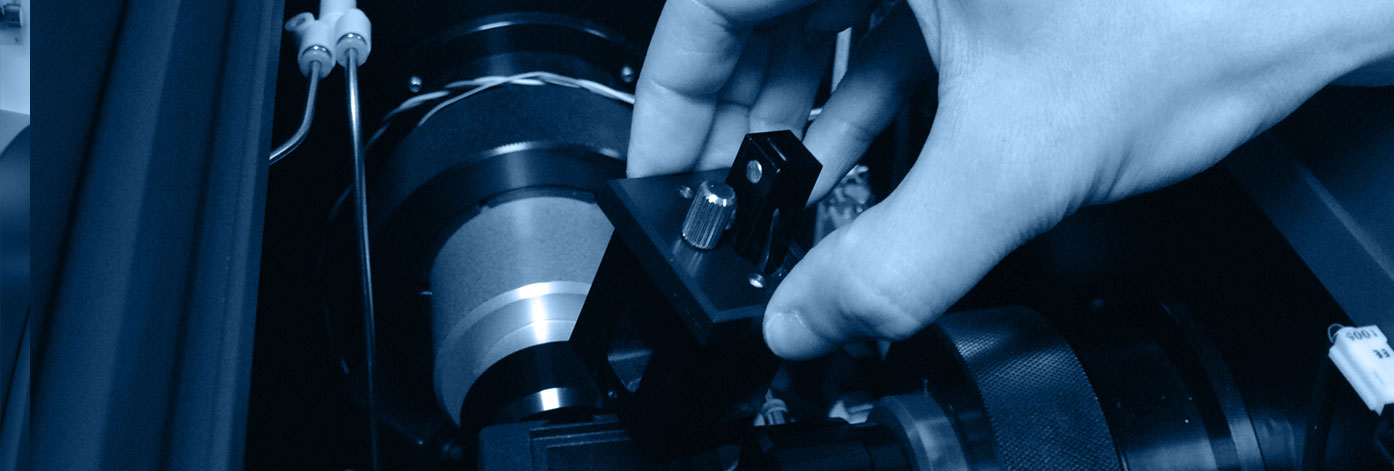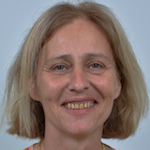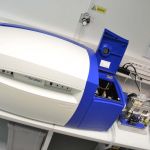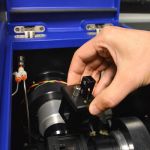
Facility
Biophysics & Structural Biology (B2S)
Circular Dichroism
Chirascan-plus can monitor absorbance and fluorescence (including anisotropy) in static or kinetic mode through an online stopped-flow module. The study of macromolecules by circular dichroism allows the analysis of their structure. For proteins, the measurement of the far-UV circular dichroism (190-260 nm) contains information on their secondary structure and the data processing by appropriate software allows an estimation of both the quantity of the different structures and their content in secondary structure in percentage. Thermal denaturation monitoring is possible thanks to a Peltier temperature control system. Dichroic signals in the near UV (250-330 nm) provide information on the environment of aromatic amino acids allowing the study of the effect of the environment on the structure of a molecule (pH, denaturation by detergents, temperature, ligand effect, molecular interactions ..). Kinetic studies can be performed with the stopped-flow accessory.
- Request form220.73 KB
- Terms and conditions89.31 KB
Analyzes can be performed in service mode or device provision mode after initial training. Contact the person in charge using the Request form to define the best strategy to adopt.
- Dos Santos Morais R, Santo PE, Ley M, Schelcher C, Abel Y, Plassart L, Deslignière E, Chagot ME, Quinternet M, Paiva ACF, Hessmann S, Morellet N, M F Sousa P, Vandermoere F, Bertrand E, Charpentier B, Bandeiras TM, Plisson-Chastang C, Verheggen C, Cianférani S, Manival X. Deciphering cellular and molecular determinants of human DPCD protein in complex with RUVBL1/RUVBL2 AAA-ATPases. J Mol Biol. 2022 Jul 25.
 10.1016/j.jmb.2022.167760 ,
10.1016/j.jmb.2022.167760 ,  35901867 ,
35901867 ,  HAL-03745381
HAL-03745381 Chagot ME, Boutilliat A, Kriznik A, Quinternet M. Structural Analysis of the Plasmodial Proteins ZNHIT3 and NUFIP1 Provides Insights into the Selectivity of a Conserved Interaction. Biochemistry. 2022 Mar 22.
 10.1021/acs.biochem.1c00792 ,
10.1021/acs.biochem.1c00792 ,  35315277 ,
35315277 ,  HAL-03617333
HAL-03617333 Dreyer A, Schackmann A, Kriznik A, Chibani K, Wesemann C, Vogelsang L, Beyer A, Dietz KJ. Thiol Redox Regulation of Plant β-Carbonic Anhydrase. Biomolecules. 2020 Jul 30.
 10.3390/biom10081125 ,
10.3390/biom10081125 ,  32751472 ,
32751472 ,  HAL-02917419
HAL-02917419 - Risser F, Collin S, Dos Santos-Morais R, Gruez A, Chagot B, Weissman KJ. Towards improved understanding of intersubunit interactions in modular polyketide biosynthesis: docking in the enacyloxin IIa polyketide synthase. J Struct Biol. 2020 Jul 25.
 10.1016/j.jsb.2020.107581 ,
10.1016/j.jsb.2020.107581 ,  32717326
32717326 S Ahmed Zennia S, Mati A, Charron C, Cakir-Kiefer C, Kriznik A, Girardet JM. Effect of nonenzymatic deamidation on the structure stability of Camelus dromedarius alpha-lactalbumin.Food Chemistry. 2019 Avril 8.
 10.1016/j.foodchem.2019.04.033 ,
10.1016/j.foodchem.2019.04.033 ,  HAL-02095313
HAL-02095313 Carrasco K, Boufenzer A, Jolly L, Le Cordier H, Wang G, Heck AJ, Cerwenka A, Vinolo E, Nazabal A, Kriznik A, Launay P, Gibot S, Derive M. TREM-1 multimerization is essential for its activation on monocytes and neutrophils. Cell Mol Immunol. 2018 Mar 22.
 10.1038/s41423-018-0003-5 ,
10.1038/s41423-018-0003-5 ,  29568119 ,
29568119 ,  HAL-01945617
HAL-01945617 Yakavets I, Lassalle HP, Yankovsky I, Ingrosso F, Monari A, Bezdetnaya L, Zorin V. Evaluation of temoporfin affinity to beta-cyclodextrins assuming self-aggregation. Journal of Photochemistry and Photobiology A: Chemistry. 2018 Dec 1.
 10.1016/j.jphotochem.2018.07.046
10.1016/j.jphotochem.2018.07.046 Roy O, Dumonteil G, Faure S, Jouffret L, Kriznik A, Taillefumier C. Homogeneous and Robust Polyproline Type I Helices from Peptoids with Nonaromatic α-Chiral Side Chains. J Am Chem Soc. 2017 Sep 27 ; 139(38):13533-13540.
 10.1021/jacs.7b07475 ,
10.1021/jacs.7b07475 ,  28837348 ,
28837348 ,  HAL-01656039
HAL-01656039







